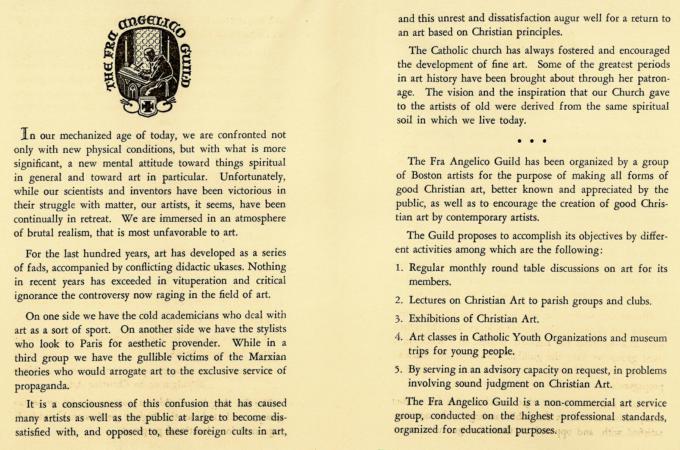The Fra Angelico Guild
On Sept. 20, 1939, a group of 10 Catholic artists met at a studio located at 3 Joy Street in Boston, with the intention of forming an organization that would help spread knowledge of Christian art. They would first take the name Guild of Catholic Artists and Craftsmen, then Guild for Catholic Artists, and later Guild for Christian Art. By late November, at the suggestion of Cardinal William H. O'Connell that they take a saint's name, they agreed on the Fra Angelico Guild. The guild was inspired by Catholic Action, which they defined as "the cooperation of the laity in the apostolate of the Hierarchy" or, in other words, lay people helping advance the mission of the Church. The term "guild" implied the group met not for the benefit of its members, but for the betterment of society. Their stated goal was to "endeavor to teach and instruct the youth both in and out of the Church and provide for them new cultural opportunities and equip them correctly with the necessary technique of appreciation of the arts."
Interestingly, the guild's papers reveal a major impetus behind their formation was communism, specifically its atheistic principles, which they perceived as a major threat to the country's youth. To combat this, they planned to work with the Catholic Youth Organization to reach young Catholics, instilling them with the principles of art and the message of the Catholic Church.
Membership was open to both men and women, and anyone who was an artist, studied art, or could assist the group in some capacity to help them achieve their mission. Father Nazareno Properzi, P.S.S.C., pastor of St. Anthony's, Somerville, had studied art in Italy and the United States and was present at the first meeting and shortly afterward officially appointed the guild's spiritual director.
The guild intended to offer art courses and arrange trips to museums for Catholic youth in the area. Another stated goal was to supply the Catholic Youth Organization and other Catholic groups with posters containing pro-Catholic messages. One of their most notable programs was their art competitions, such as the two contests held in 1941, the first calling for works depicting the Blessed Kateri Tekakwitha, and the second for Madonnas. The guild was only active for a short time, ceasing its activities in 1947.
The guild's namesake, Fra Angelico, was a painter born Guido di Pietro around the year 1400 in Vicchio, Florence, Italy. Around 1420 he became a Dominican Friar and took the name Fra Giovanni da Fiesole; Fra Angelico means "Angelic Brother."
The renowned painter Fra Angelico is not only one of the most celebrated artists in Western European history but also one of its most talented storytellers. His influence reached its height from about 1440 to 1450, during which time he was invited to Rome by Pope Eugene IV where he worked from 1446 to 1450. He would return to Rome again in 1453, and passed away there on Feb. 18, 1455, and was buried at the church of Santa Maria sopra Minerva.
The vast majority of his famous narrative cycles are large-scale frescos embedded in the walls of Italy's most famous churches -- from San Marco, Florence and Orvieto Cathedral to the pope's private chapel in the Vatican. Yet he poured the same creativity and ingenuity into a series of jewel-like paintings depicting the life of the Virgin Mary. Originally conceived as reliquaries -- containers for the body parts or clothing fragments of saints -- three belong to the Museo san Marco, Florence and the fourth (The Death and Assumption of the Virgin Mary) is one of the masterpieces of the Isabella Stewart Gardner Museum. Starting Feb. 22 and running until May 20, the Isabella Stewart Gardner Museum in Boston will be hosting an exhibit titled "Fra Angelico: Heaven on Earth," for the first time offering an opportunity to experience a complete narrative cycle by Fra Angelico.
For more details, including hours, admission, and a schedule of special events, please visit www.gardnermuseum.org.
- Thomas Lester is the archivist of the Archdiocese of Boston.



















